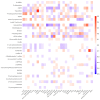Prediagnostic Plasma Nutrimetabolomics and Prostate Cancer Risk: A Nested Case-Control Analysis Within the EPIC Study
- PMID: 39682302
- PMCID: PMC11639937
- DOI: 10.3390/cancers16234116
Prediagnostic Plasma Nutrimetabolomics and Prostate Cancer Risk: A Nested Case-Control Analysis Within the EPIC Study
Abstract
Background and Objective: Nutrimetabolomics may reveal novel insights into early metabolic alterations and the role of dietary exposures on prostate cancer (PCa) risk. We aimed to prospectively investigate the associations between plasma metabolite concentrations and PCa risk, including clinically relevant tumor subtypes. Methods: We used a targeted and large-scale metabolomics approach to analyze plasma samples of 851 matched PCa case-control pairs from the European Prospective Investigation into Cancer and Nutrition (EPIC) cohort. Associations between metabolite concentrations and PCa risk were estimated by multivariate conditional logistic regression analysis. False discovery rate (FDR) was used to control for multiple testing correction. Results: Thirty-one metabolites (predominately derivatives of food intake and microbial metabolism) were associated with overall PCa risk and its clinical subtypes (p < 0.05), but none of the associations exceeded the FDR threshold. The strongest positive and negative associations were for dimethylglycine (OR = 2.13; 95% CI 1.16-3.91) with advanced PCa risk (n = 157) and indole-3-lactic acid (OR = 0.28; 95% CI 0.09-0.87) with fatal PCa risk (n = 57), respectively; however, these associations did not survive correction for multiple testing. Conclusions: The results from the current nutrimetabolomics study suggest that apart from early metabolic deregulations, some biomarkers of food intake might be related to PCa risk, especially advanced and fatal PCa. Further independent and larger studies are needed to validate our results.
Keywords: EPIC; nested case–control; nutrimetabolomics; prostate cancer.
Conflict of interest statement
The authors declare no conflicts of interest.
Figures



References
-
- Wild C.P., Weiderpass E., Stewart B.W., editors. World Cancer Report: Cancer Research for Cancer Prevention. International Agency for Research on Cancer; Lyon, France: 2020. - PubMed
-
- Cicione A., Brassetti A., Lombardo R., Franco A., Turchi B., D’Annunzio S., Nacchia A., Tubaro A., Simone G., De Nunzio C. Metabolic Syndrome and Physical Inactivity May Be Shared Etiological Agents of Prostate Cancer and Coronary Heart Diseases. Cancers. 2022;14:936. doi: 10.3390/cancers14040936. - DOI - PMC - PubMed
Grants and funding
LinkOut - more resources
Full Text Sources

